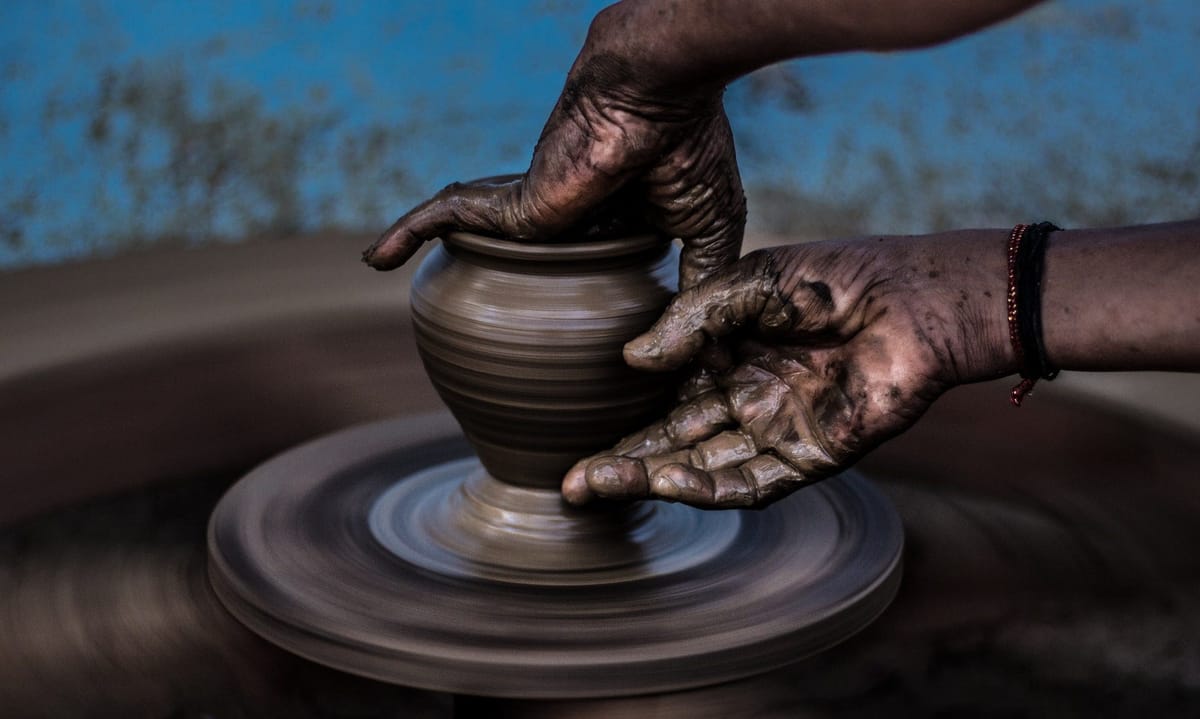What are Crafts and Why They are Important
Every craft should be part of a cyclic process of taking from nature and giving back in one form or the other.

What is a Craft?
A craft or trade is an activity, pastime, or profession that necessitates skills, experience, and artisanship to create something meaningful, palpable, and tactile. Nowadays, even programming and having digital skills or being very good at utilizing technology can be blanketed under crafts.
What is the Purpose of Crafts?
A craft is a means through which an individual exercises their abilities, talents, or gifts. Crafts can be a way to be of service to others and even earn a living. Crafts can be anything from woodwork, pottery, being a blacksmith, painting, music, and many others. A craft is a culmination of the input of experience, skills, passion, and hard work into creating and translating forms of matter.
Crafts as the Precursor to Inventions
Crafts are inherently human and can get traced back to millennia ago when early man discovered the use of numerous rocks or sticks for different uses. As is said, necessity is the mother of invention, and most of the crafts we love and appreciate today got commenced out of necessity. For instance, during the stone age, early man discovered the use of sharp rocks as cutting devices out of the need to separate or cut food such as meat.
Through such necessity, the process of realizing modern knives and blades started with the sharpening of stones to give them sharp edges that could serve the purpose of cutting. Human nature and human behavior indicate that when there is a need, ingenuity sprouts. The human species is very much a solution-seeking species, in a way that creates a whole world of wonder that is arts and crafts.
The Woodworking Craft and Why It is So Impressive
When I think of woodwork, I am amazed by the kind of attention to detail, imagination, and skills that go into designing furniture. You can imagine how arduous it is to find a suitable tree, cut it down, separate it into workable chunks, and then design it into something meaningful.
DIY Furniture and How You Can Do Some Woodworking
The modern world and consumerism have led to the deterioration or reconfiguration of such skilled art forms and crafts, with the invention of do-it-yourself or DIY furniture. The craft that is woodwork is naturally a process of toil, sweat, and skill.
Those who have mastered this art are individuals who have evolved into becoming excellent in woodworking. There are generations and generations of people that have inherited and passed on very vital skills and knowledge on crafts and several art forms. I think it is a wonderful thing to inherit a skill or craft.
The Evolution of Man's Relationship with Wood
Wonderful woodwork pieces such as Kanghas are unique and beautiful to behold. Woodwork is an excellent craft, and as a human species, we have evolved along with trees and have been supported by trees since early man. Trees have been a source of shelter, firewood, and heating, a source of food and fruits, and a very significant part of the environment. You can imagine the world without trees and what an unnatural world it would be.
Why It is Important to Conserve the Environment and Conserve Crafts Such as Woodworking
Trees are sacred, and anyone cutting down a tree should ensure they replace it with two. Trees should get cut when it is absolutely necessary as they are very crucial to the ecosystem. Trees attract rainfall and provide shelter for birds, animals, plants, and even human beings. We frown upon de-afforestation and encourage reafforestation and afforestation to the greatest extent possible. Every one of us should have several trees that we are looking after.
The Craft of Sculpting
Working with wood is very much like carving or being a sculptor. It is fascinating to think that we, as the human species, have, for centuries, learned to sculpt stone and other materials into beautiful pieces of artwork. The process is arduous, to say the least, as it could take years to turn a stone into a beautiful sculpture. You can imagine starting from a block of stone and chipping away in a very professional and specific way to produce a sculpture.
The Importance of Hands-On Skills
Such skills are priceless, and anyone with the ability to sculpt should ensure that they teach others. They should have apprentices to who they can pass on the skills and knowledge and who would do the same. Skills should get documented and passed on from one generation to the other, as a way to ensure that some skills do not go extinct.
The Wonder of Sculpting and Why We Should Preserve Sculpting Skills
Sculpting is very much a phenomenal craft and is simply part of the cultural heritage of the world. Sculptors sculpt stone, metal, ceramics, and even wood. Creating sculptures is an art form that should be protected and taught to the younger generations. When we preserve and conserve such skills and knowledge, we branch them out and allow for new and emergent skills and crafts.
For instance, through the expression and passing down of sculpting, the greek art masters were able to produce masterpieces that are today appreciated as the renaissance of Greek art and the artistic genesis of numerous designs and styles of sculpture.
What are Abstract and Non-Tactile Crafts?
Crafts can also be abstract and non-tactile. An excellent example is music and the visual arts, including acting, film, and drama, among others. These are arts that are expressed through the senses and felt or appreciated again through the senses.
The Craft of Music
The human configuration is one of marvel, and you can imagine if music were a physical thing, then a lot of us would be carrying a lot of it around while experiencing or ‘listening’ to it. It is a pleasure and a beauty of nature that music is something that we not only perceive or experience through the sense of hearing but also an art that evokes emotion and feeling.
Picture a concert hall with thousands of people going completely mental at the sounds of the music they love. Such is the effect that a craft, art form, or talent such as music can have.
The Role Our Experiences Play in How We Experience Different Art Forms
We all experience different art forms differently, and some will listen to music actively or passively, and that is the beauty of arts and crafts. Our personalities reflect in the various ways we digest, imbibe, or take in different art forms. For example, some people will walk into a gallery and see a painting’s overall or perceivable representation.
On the other hand, others will walk in and get hit by the detail and emotion of the same piece. As such, experiencing crafts or art forms is very much an art of its own and a matter of taste, how cultured the individual is, their interests, and knowledge.
The Art of Weaving Fabrics
Here in Kenya, a Kiondo or a basket may get appreciated as an everyday carrying item. However, for those who have seen and appreciate its artistry, it is a fashion piece worthy of the runway on fashion week in Paris, New York, or Milan fashion week. The same holds for the Kitenge, Kanga, and Dashiki, among many other African fabrics and art forms. These are pieces of artwork and crafts that need to get preserved, conserved, and passed on from one generation to the other.
The Artistry in Weaving and Fashion Design
You can imagine the artistry, effort, and skill it takes to create a Sari and embellish it with beautiful ornaments. Such crafts are priceless and make the world what it is today; the best representation of artistic expression. Some fabrics require intricacy that is comparable to that of quilling and quilling arts.
The Incredible Artistry of Quilling
Using a quilling pen, specialists can resemble quilling paper designs and produce patternations such as paper quilling flowers. These are designs that can be used to decorate fabrics, cards, and jewelry, among others. Fashion is a craft in its own right, and fashion shows require intense artistry, just like the expression of all other crafts.
The Culture of Crafts
To have a craft is not necessarily to be artsy and even those who deal with crafts such as shoemaking, calligraphy, printing, and many others serve a purpose to produce functional pieces. Tailoring is such a craft and is an excellent representation of human ingenuity and complex artistic expression. Visit India, and you can have a suit designed for you to meet your specific shape, size, and preference. You can get a tailor-made suit anywhere in the world in an urban setting.
The Beauty and Importance of the Cultural Underpinnings of Crafts
However, places like India have a lot of culture, appreciation, and experience with textiles. It is like sourcing wine from somewhere where vineyards have only been grown for the last century or visiting Champagne, France, where wine production has been underway for millennia. Champagne wine region commenced wine production in the middle ages and has had thousands of years to perfect the craft. Perfecting a craft is a process that can take thousands of years and evolves as part of the culture and traditions of a particular society or community.
The Necessity of Hard Work in Honing Skills in a Certain Craft
A lot of hard work goes into learning the skills and knowledge needed to be effective and expressive in a particular craft. It is the reason why there are music schools, acting schools, culinary schools, and the like. Immense effort and hard work go into understanding how to undertake a craft and doing it in a way that speaks to others, and to those who understand or appreciate the craft.
An excellent example is being a chef. To get a Michelin star, a chef must intricately know their craft. It is like becoming a tenor in the Royal Opera House. Learning and perfecting a skill is an arduous process that requires unfaltering commitment, dedication, passion, and mountains and mountains of practice.
What It Takes to be a Successful Craftsman or Woman
Smart work sounds good, but hard work is what's needed to become a successful craftsman or woman. Those who sing opera, for instance, take thousands and thousands of hours each year perfecting their craft. The same holds for pilots who get graded by their flight hours.
The more flight hours the pilot has, the more experienced they become regarded. Success is only reachable for those who toil and do it with passion, commitment, and dedication. Ambition also has a lot to do with success, and those who aspire to be more allow themselves the drive and motivation to pursue greatness.
How Crafts and Pastimes Intersect
Pastimes such as sailing and even similar sports can become regarded as crafts. These are pastimes that require a lot of skills and training, such as archery, horse racing, and the like. A fascinating thing about crafts is the value they bring to life. An excellent illustration of this is the absolute cheer and joy that fills the arena or racecourse when horses are racing.
Owners whose horses are winning may burst into cheer and joy and draw so much pride in seeing their horses win. It is a source of pride as they have, by that time, input a lot of time, money, and hard work into getting a horse into a derby and having it win.
The Work Behind the Craft of Horse Rearing
Most of us never see the work that goes into something like horse racing, i.e., rearing the horses, breeding them, feeding them, treating them when ill, and the like. Extensive hard work goes into success, and that is why success is an experience in itself.
We all have the capacity to succeed, and each has something that we can put out to the world and build on the crafts that are there. We all have evolved along with craftmanship, and all can relate to one craft or the other.
The Materials that Go into Crafts and Why They are Important
Materials are a vast part of the input that goes into all crafts. Painters need brushes, sculptors need stones, woodworking necessitates wood, and so on. Materials and especially natural materials are essential to the longevity and existence of specific crafts. For instance, without adequate, quality, and reliable sources of leather, leather tanning would become obsolete, and this would limit the availability of genuine leather products.
Why It is Important to Produce Materials Inputs for Crafts Sustainably
Crafts necessitate the sustainable production of materials such as wood and leather and doing it in a way that complements the environment. Climate change has become exacerbated by the unsustainable sourcing of materials, and can only be reversed or mitigated by ensuring that we nourish and rejuvenate the environment. If we plant millions or even billions of trees globally, we will have a better chance of mitigating climate change and its adverse effects.
The Importance of Sustainable Design and Craftwork that Cares for the Environment
Sustainability also touches on producing items and goods using renewable materials and renewable sources of energy. As such, craftsmen and women should be at the forefront of promoting sustainable ways to produce goods and ensuring that whatever they make is done in a way that complements their natural surroundings.
Avoiding the Negative Effects of Mining and Material Sourcing
It would be unfortunate for those who mine marble to leave sinkholes or unsafe caves or quarries that endanger human, animal, or other species’ life. Carpenters and those who work with timber should also ensure that they undertake reafforestation and use wood sustainably, and in a way that minimizes wastage. An excellent example of doing this is reusing sawdust as mulch for plants. Doing this would ensure that the sawdust gets reintroduced to the ecosystem in a way that complements plant growth.
The Importance of Inculcating a Cyclic Process in Craftwork
Every craft should be part of a cyclic process of taking from nature and giving back in one form or the other. Sculptors, on their part, can create beautiful sculptures to be placed in botanical gardens and parks. These sculptures would, in turn, attract visitors and generate revenue for environmental conservation and preserving green spaces. All crafts can play a role in the betterment of society and the preservation of cultural heritage and the environment.





